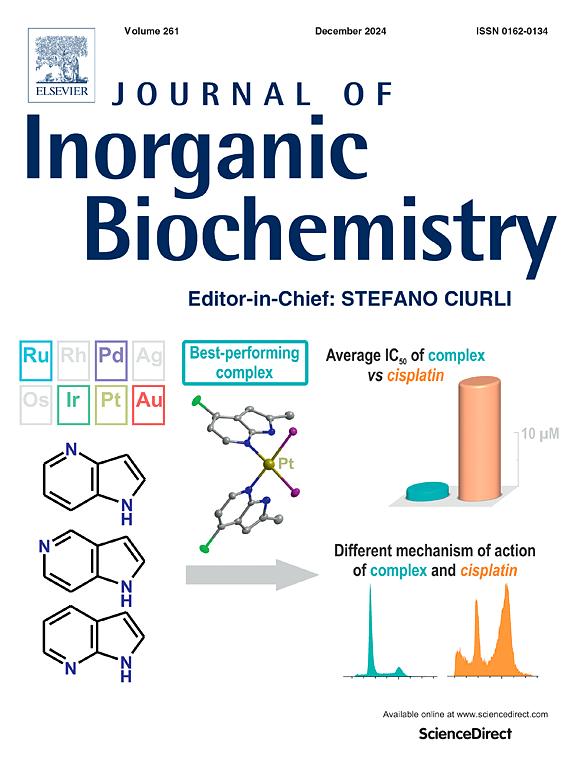Design and characterization of porphyrin-based photosensitizing metalloproteins integrated with artificial metalloenzymes for photocatalytic hydrogen production
IF 3.8
2区 化学
Q2 BIOCHEMISTRY & MOLECULAR BIOLOGY
引用次数: 0
Abstract
Hydrogen is regarded as a promising alternative to fossil fuels. A desirable method of its generation is via photocatalysis, combining photosensitizers and hydrogen-evolution catalysts in the presence of an electron donor. Inspired by natural photosynthesis, we designed photosensitizing artificial metalloproteins (ArMs) and integrated them with ArM-based catalysts for photocatalytic hydrogen production from water. Metal porphyrins based on protoporphyrin IX (PPIX) were employed as they are naturally abundant and are effective both as photosensitizers and hydrogen-evolution catalysts. Photosensitizing proteins were created by binding zinc (Zn)PPIX or ruthenium (Ru)PPIX to the haem acquisition system A from Pseudomonas aeruginosa (HasAp). The photosensitizer ArMs were combined with cobalt (Co)PPIX-myoglobin (Mb) or free CoPPIX as hydrogen evolution catalysts. We found that free CoPPIX could replace ZnPPIX or RuPPIX in HasAp, forming CoPPIX-HasAp or RuPPIX-CoPPIX-HasAp complexes with enhanced stability compared to CoPPIX-Mb. Photocatalytic hydrogen production was achieved upon irradiation at 435 nm (ZnPPIX) or 385 nm (RuPPIX), using methyl viologen as an electron carrier and triethanolamine as an electron donor. The ZnPPIX-HasAp/CoPPIX-HasAp system remained intact and active for approximately 42 h, while Ru-based systems that were excited by UV light, exhibited signs of protein cleavage upon prolonged irradiation. These results demonstrate the potential of integrating porphyrin-based ArMs for photosensitization and hydrogen evolution, with HasAp providing a robust scaffold for sustained photocatalytic activity.

结合人工金属酶光催化制氢的卟啉光敏金属蛋白的设计与表征
氢被认为是一种很有前途的化石燃料替代品。其产生的理想方法是通过光催化,在电子供体存在下结合光敏剂和析氢催化剂。受自然光合作用的启发,我们设计了光敏人工金属蛋白(arm),并将其与arm基催化剂相结合,用于光催化水制氢。基于原卟啉IX (PPIX)的金属卟啉是天然丰富的,是有效的光敏剂和析氢催化剂。通过将锌(Zn)PPIX或钌(Ru)PPIX与铜绿假单胞菌(HasAp)的血红素获取系统A结合,制备出光敏蛋白。将光敏剂ArMs与钴(Co) ppix -肌红蛋白(Mb)或游离CoPPIX结合作为析氢催化剂。我们发现免费的CoPPIX可以取代HasAp中的ZnPPIX或RuPPIX,形成与CoPPIX- mb相比稳定性增强的CoPPIX-HasAp或RuPPIX-CoPPIX-HasAp复合物。在435 nm (ZnPPIX)或385 nm (RuPPIX)的辐照下,以紫紫甲基为电子载体,三乙醇胺为电子供体,实现了光催化制氢。ZnPPIX-HasAp/CoPPIX-HasAp系统在大约42小时内保持完整和活性,而基于ru的系统在紫外线激发下,在长时间照射下表现出蛋白质切割的迹象。这些结果证明了将基于卟啉的arm整合到光敏化和析氢方面的潜力,HasAp为持续的光催化活性提供了一个强大的支架。
本文章由计算机程序翻译,如有差异,请以英文原文为准。
求助全文
约1分钟内获得全文
求助全文
来源期刊

Journal of Inorganic Biochemistry
生物-生化与分子生物学
CiteScore
7.00
自引率
10.30%
发文量
336
审稿时长
41 days
期刊介绍:
The Journal of Inorganic Biochemistry is an established international forum for research in all aspects of Biological Inorganic Chemistry. Original papers of a high scientific level are published in the form of Articles (full length papers), Short Communications, Focused Reviews and Bioinorganic Methods. Topics include: the chemistry, structure and function of metalloenzymes; the interaction of inorganic ions and molecules with proteins and nucleic acids; the synthesis and properties of coordination complexes of biological interest including both structural and functional model systems; the function of metal- containing systems in the regulation of gene expression; the role of metals in medicine; the application of spectroscopic methods to determine the structure of metallobiomolecules; the preparation and characterization of metal-based biomaterials; and related systems. The emphasis of the Journal is on the structure and mechanism of action of metallobiomolecules.
 求助内容:
求助内容: 应助结果提醒方式:
应助结果提醒方式:


